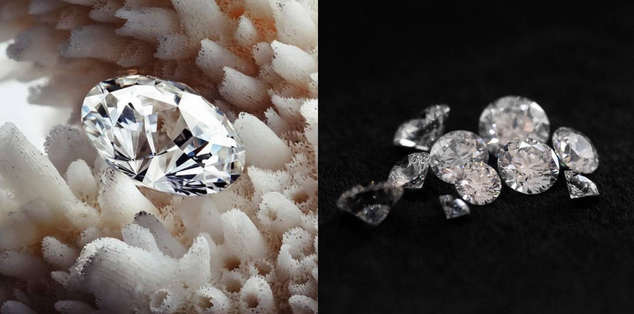
What are lab grown diamonds, how are they made, how are they the same and different from mined diamonds, the benefits of lab grown diamonds and how is the diamond industry responding to the rise of lab grown diamonds.
How is the diamond industry responding to the rise of lab grown diamonds?
Traditional diamond mining companies have spent a lot of energy trying to build a story that mined diamonds are "natural" and that lab grown diamonds are different from mined diamonds. They have spent billions of dollars on advertising about the disruptive nature of lab grown diamonds to the diamond industry. Just like they did when they convinced consumers that they needed to spend 2 months' salary on an engagement ring and that it had to be adorned with diamonds (all of which De Beers made up in their advertising campaign).
While the diamond industry has tried to convince us in the past that mined diamonds are better than lab grown ones, they are investing in lab diamond production themselves. To avoid damaging their existing brands and lucrative profits, they have created separate brands of lab grown diamonds, which are often aimed at a younger, less affluent audience.

The mined diamond industry tries to make a distinction between lab grown diamonds and mined diamonds, often referring to mined diamonds as "natural" diamonds. However, as stated earlier, there is no difference between diamonds extracted from the earth and those made in a laboratory. So why do mining companies desperately try to distinguish between them? The reason, of course, is that their business model is being challenged. They even lobbied the government to mandate that lab grown diamonds not be called "diamonds", but without success (because they are). However, lab grown diamonds must still be marked as lab-made on the certificate of authenticity and girdle.
What is a lab grown diamond?
As the name implies, lab grown diamonds are artificially created in a laboratory using high technology and are 100% physically, chemically and optically identical to mined diamonds. The only difference is the way they are sourced. In short, lab grown diamonds are real diamonds, just like mined diamonds. They are simply made in the lab, not taken out of the mine.
How are lab grown diamonds made?
Lab grown diamonds, also known as man-made diamonds, synthetic diamonds or lab diamonds, are manufactured in a laboratory using advanced technology to reduce production time. There are two main methods of growing diamonds in the laboratory, both of which can produce diamonds that are just as stunning as mined diamonds.
Chemical Vapor Deposition (CVD)
While the first method mimics the formation process of a diamond deep in the earth's crust, the chemical vapor deposition (CVD) process relies on the formation of a carbon-rich gas around the seed. Unlike the HPHT method, it requires less pressure, lower temperature, and less space.
First, the seeds are placed in a sealed chamber, which is then filled with a carbon-rich gas, such as methane or hydrogen. When heated to about 800 degrees Celsius (1,500 degrees Fahrenheit) and ionized, the gas turns into a plasma that breaks down and carbon atoms begin to form around the seeds. The carbon "rains" on the seeds, stacking atoms on top of each other. They stick to the seeds one by one (somewhat similar to 3D printing).
Recent technological improvements have given the CVD process an advantage over the HPHT method. Both methods have the same advantages over mined diamonds: lower cost and lower negative environmental and social impact.
What is the difference between mined and lab grown diamonds?
The process of cutting and polishing lab grown diamonds is the same as for mined diamonds. Likewise, the inspection and grading processes are the same and are performed by the same laboratories. Therefore, they are indistinguishable at both the aesthetic and molecular levels.
The only difference between mined diamonds and lab grown diamonds is the method of origin; mined diamonds were created billions of years ago and require extensive mining operations from the earth to dig them out, but lab grown diamonds can be manufactured in a laboratory through a controlled process that reduces costs, energy consumption and eliminates negative impacts on the local environment and society.
To explain why the production process makes lab grown diamonds cheaper and better for the environment and society, we will delve into the exact way that mined diamonds are extracted and the exact way that lab grown diamonds are produced.
High Pressure High Temperature (HPHT)
This method mimics the formation process of mined diamonds in the earth's interior, i.e. high pressure and high temperature. Simply put, very high heat and tremendous pressure squeeze pure carbon atoms together to form a diamond. The diamond seed is first placed in pure graphitic carbon and exposed to extreme heat of over 2,700 degrees Fahrenheit (1,500 degrees Celsius) and crushing pressure of 1.5 million pounds per square, then the pure carbon surrounding the seed melts. Finally, it is cooled and forms a diamond shape around the starting seed.
Are lab grown diamonds a recent invention?
Growing diamonds in the laboratory is not a recent invention. Diamonds have been manufactured in laboratories for over 60 years, first successfully grown by General Electric (GE) researchers in 1954. In the beginning, lab-made diamonds were not gem-quality and were only used for industrial applications. The first gem-quality diamonds were produced in laboratories in the early 1970s. But it was only recently that production costs made them available for mass consumption. In the last few years, technological advances have further reduced the cost of producing gem-quality diamonds to even less than the cost of mining them.
Are lab created diamonds cheaper than mined diamonds?
Thanks to recent technological advances, lab made diamonds are now less expensive to manufacture and purchase than mined diamonds. In addition, they are not only more affordable, but they also have clear and documented environmental benefits.











